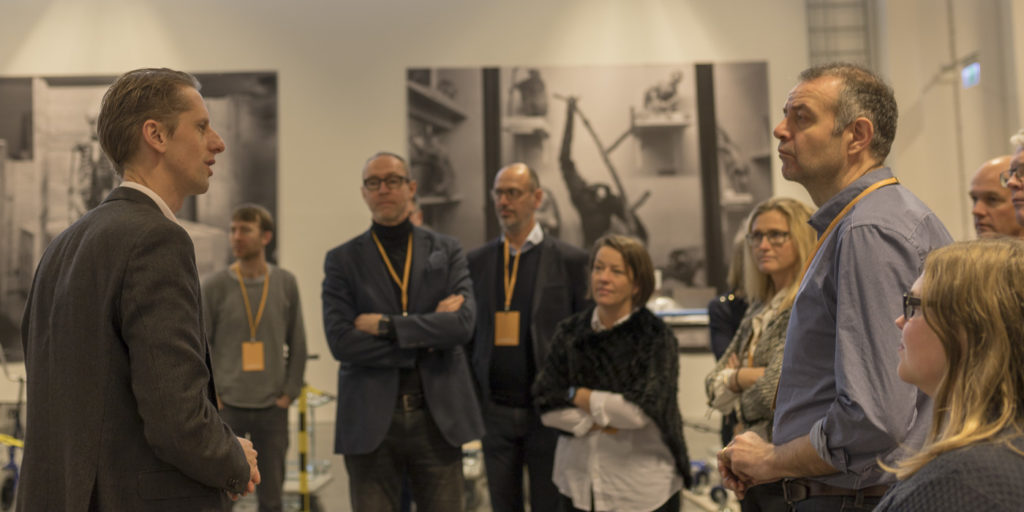
Lund max iv och nod-0404
Autumn workshop and a study visit to Max IV
“You cannot approach Max IV just outside Lund without being impressed by the facility,” says Medtech4Health’s Communications Officer Kristina Svensson. At the end of November, Medtech4Health’s programme office visited Max IV on a study visit at the beginning of our autumn workshop.
Autumn workshop
The Medtech4Health autumn workshop was an opportunity for participants to discuss the programme office’s focus for the coming years. The Board had indicated that they see internationalisation and procurement as two vital questions. Among other issues and ideas that were raised during the meeting were:
- the need to highlight the results of funded projects more than we do today,
- innovation contests with colleagues in other Strategic Innovation Programmes (SIPs),
- a network for women in medical technology,
- follow-up research,
- more focus on our geographic white spots,
- a gender review of the texts of calls for funding applications.
Everyone in the programme office added ideas to a document in our common Dropbox folder. Working groups were set up around the ideas that attracted the most interest.
The actual meeting took place at RISE (Research Institutes of Sweden) in Lund. Instead of the usual group photo from the meeting, here is a picture of the workshop in action. From the left, Reidar Gårdebäck (Programme Director), Pontus von Bahr (Vinnova), Monika Lydin (RISE), Henrik Mindedal (MedTech West), Tomas Jansson (Medicon Bridge), Lena Strömberg (Medtech4Health / Impact), Bertil Guve (KTH), Sebastian Möller (Medicon Bridge), Frida Lindberg (KTH), Sara Qvarlander (CMTF), Olof Lindahl (CMTF) and Kristina Svensson (Medtech4Health – represented in the picture by the hat).
Max IV – a very large microscope
At the risk of being irreverent, Max IV is basically a very big microscope. What is most visible is the large storage ring, 528 meters in circumference. This in itself does nothing dramatic, only spins electrons around in a thin vacuum tube. It is the experiment stations added to the ring that create the magic. These are called beamlines and have names like BioMax and NanoMax. There is room for a total of thirty beamlines and funding, so far, for fifteen. This is where the experiments are carried out. Medtech4Health visited the beamline called Balder, which is not yet connected to the storage ring.
Two members of staff are assigned to each beamline. Their job is to help the researchers who come to Max IV to carry out experiments using the equipment. There are two ways to access beam time, either by applying for time as an academic institution or by buying time as a commercial operation. Applications represent the overwhelming majority of beam time use. They are allocated based on the research level of the proposed project. The results of academic experiments must be published. The advantage of paying for beam time commercially is that the results need not be published, which may be attractive to larger companies.
Metallic materials, another SIP, had a two-day workshop in June, discussing how Max IV can be used in their area. Is there something to be gained for Medtech4Health in using Max IV?
AKTUELLT
Glad sommar önskar vi från Medtech4Health
Efter en intensiv vår är det snart dags för en välbehövlig sommarpaus. Men först ser vi fram emot att ses i Almedalen där vi är en del av mötesplatsen Tillsammans.
SO Västra stärker innovationskraften genom samverkan och erfarenhetsutbyte
Medtech4Healths nod SO Västra har gjort programmet till en naturlig del av innovationsarbetet i Västra Götaland. Här finns en stark samverkan där metoder och erfarenheter delas framgångsrikt.
Nytt verktyg ska bana vägen för smidigare breddinförande av medicinteknik
Först ut från Medtech4Healths strategiska projekt MedImpact är ett instrument för enklare breddinförande av teknik för egenmonitorering. Med instrumentets frågebatteri blir det möjligt att undvika fallgroparna vid ett breddinförande. Instrumentet finns på Medtech Arena.
Nya satsningar ska göra det lättare för små innovativa medicintekniska företag
Regeringen har gett flera nya uppdrag till myndigheter som arbetar med medicinteknik. Målet är att stärka sjukvården och förbättra Sveriges beredskap vid kriser.
NYHETSBREV
Följ nyheter och utlysningar från Medtech4Health - prenumera på vårt nyhetsbrev.







